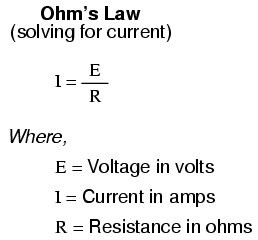History of Computers - Ohm's Law
In 1827, George Simon Ohm introduced Ohm's Law, a mathematical description of the physics of electricity.
Contents
Overview
Ohm's law describes the relationship between current, voltage, and resistance through this mathematical equation:

Ohm's Law is applicable to electrical circuits. Ohm's Law states that the current through a conductor between two points is directly proportional to the voltage across the two points and inversely proportional the to the resistance between them.[1]
Ohm's Law is used when calculating anything to do with circuits. For example, when trying to build a circuit that will act as an infrared sensor, Ohm's law can be used to calculate how strong of a resistor is needed to allow the circuit to function without overloading or blowing a component. It is used for almost any electrical application and such a simple thing as I=V/R makes so many things possible and saves many components of circuits and people from unnecessary accidents. Ohm's Law takes most of the guess work out of electricity by providing a mathematical foundation for it.
Significance
Several mathematical discoveries such as Ohm's law helped advance the field of the physics and math of electricity into what we know today. This information describing electricity is incredibly important to all electronic devices invented. Knowledge of the behavior of electricity is significant to computers because electricity changed computers into mechanical computing machines into electric computers. This leap from types of computing machines took away the limitations of the computer on a macroscopic scale, and turned the computer into a microscopically working device. Electric computers are a major advance from their mechanical predecessors because of their size, speed, computing ability, and practicality. Without this crucial discovery, the science behind electrical computers would be absent, and electrical computers would be impossible. The knowledge of Ohm's law led to new electric computers like the Electronic Tabulating Machine, the Colossus Computer, and ENIAC.
Links
References
http://en.wikipedia.org/wiki/Ohm's_law
http://www.the12volt.com/ohm/ohmslaw.asp
Cite error: <ref> tags exist, but no <references/> tag was found